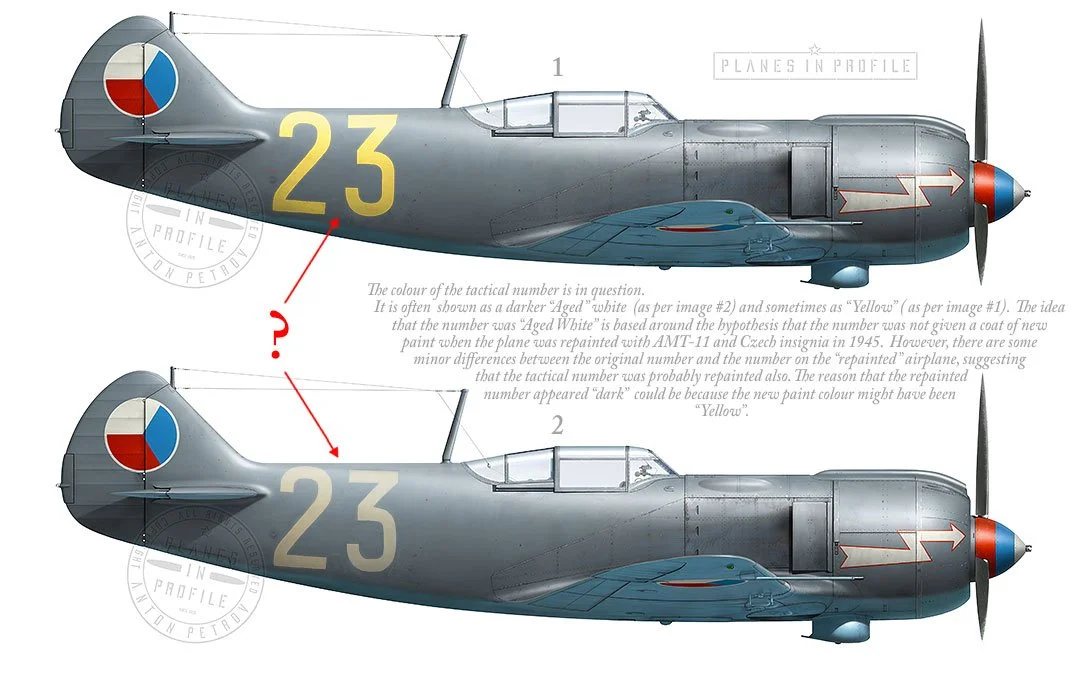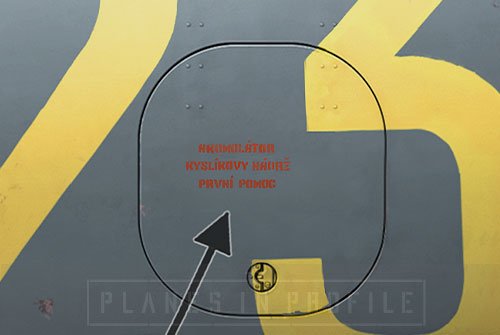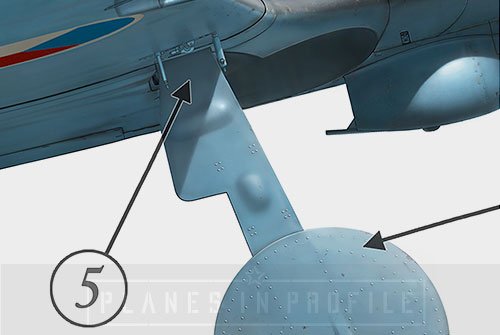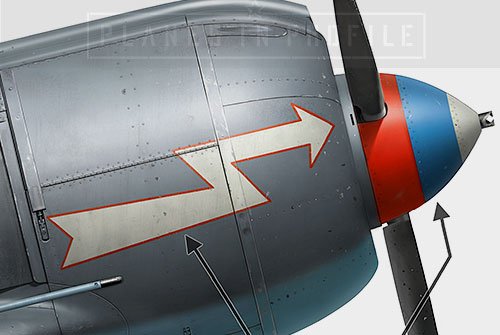Vendl’s “White-23” / Czech “(Yellow?)-23”,
Lavochkin, La-5FN (Early)
Airplane Serial Number 39211923, Engine Serial number 8212450
Antonin Vendl’s “White-23”
1st Czechoslovak Independent Fighter Regiment
Flown by ppor. Antonin Vendl, and others, including ppor. František Štička and šrtm. Anton Matušek [3].
Czech “(Yellow?)-23”
2. stíhací letecký pluk, 4. smíšená letecká divize, Czechoslovak Air Force, Piešťany airfield, February, 1946.
Flown by various pilots of the Czechoslovak airforce, including rtm. Michal Jánoš
Origins
White-23 was one of the original 22* planes which were given to the newly formed 128th Československá samostatná stíhací letecka perut v SSSR (Czechoslovak Independent Fighter Air Squadron in the USSR) of the Soviet VVS in May 1944. This squadron began its formation in April of 1944, in USSR. Soon after it was formed, it was renamed into the 1st československý samostatný stíhací letecký pluk (čsslp) (Czechoslovak Independent Fighter Air Regiment), and retained that name until it was reorganised into the 1st Czechoslovak Mixed Air Division in USSR, in January of 1945. The regiment operated under the command of the Soviet VVS throughout the war and its planes carried Soviet insignia. The 1st čsslp consisted of experienced Czech fighter pilots who previously fought in the ranks of the British RAF and who were sent by the Czech government in England to the USSR, to help the Red Army fight Germans on the Eastern Front. These pilots (About 21 of them) arrived to USSR on the 14th of April 1944 and began training to fly the La-5FN airplanes soon after at the Kubinka air base. When the regiment received its 22 La-5FNs, White-23 was assigned to Antonin Vendl . It’s worth noting that the 1st čsslp received two ‘White-23’ airplanes, the second plane number 23 was assigned to ppor. B. Mráz. It was probably in order to distinguish between the two planes that Antonin Vendl’s White-23 had a large white band painted around the fuselage, covering one of the digits of the tactical number on the left and the right sides of the plane. This photo (though unfortunately a very low resolution one) shows Antonin Vendl’s White-23 in flight (in the background) while the pilots are training at the Kubinka airbase. The white band can be seen already painted on the fuselage.
Illustration above is my attempt at a reconstruction of Vendl’s “White-23” as it appeared during pilot training at the Kubinka air base in USSR, before the 1st čsslp was sent to Slovakia. Note that the tailwheel is down in the illustration. In the photo linked above all the airplanes have their tailwheels down. At first one might suppose that their tailwheels were the non-retractible type, but we know that at least one of the planes (White-12) had the tailwheel doors present, as can be seen in THIS PHOTO, suggesting that it was most likely a retractible tail wheel after all, or at least that the tailwheel doors were present on it and therefore probably on White-23 also. Perhaps the reason the tailwheels appear in the ‘down’ position in the photo of the flying airplanes is because the planes just took off? In my artwork I drew the plane with the tailwheel down and with the tailwheel doors present, to stay true to the photo reference and what I know about the 1st čsslp’s White-12 airplanes.
The camouflage on Vendl’s White-23 was very difficult to determine from the low resolution photograph. Above is the study I used to help me figure out the camo. pattern which was rather non-standard on most La-5s of the 1. čsslp. There is a theory that the La-5s of this regiment might have been repainted early on during their service, which is why the pattern on most of them showed some deviations from the standard Grey/Grey template.
Combat Action
By June the pilots were combat ready and by the end of July 1944, the 1st Czech Independent Fighter Regiment became a part of the 2nd Air Army, 1st Ukrainian Front, commencing battle action on the 10th of September 1944 in south-eastern Poland. 5 days later, when the Slovak resistance movement launched the Slovak National Uprising, the regiment with its 21 La-5 fighters* was sent to Slovakia to support the Slovak insurgents. The 1st Czech Independent Fighter Regiment proved itself to be a powerful force during the battles of the S.N.U.
During the S.N.U. in Czechoslovakia the regiment was based mainly on the rather basic grass airfield in Zolna where it arrived on the 17th of September, and later on a larger and better equipped airfield in Tri Duby, both of them in the insurgent-held territory of Czechoslovakia. The tasks of the regiment varied, they included reconnaissance missions, air support of the front line ground forces and other combat and bombing raid missions. During the Slovak Uprising, which lasted until late October, the regiment destroyed 2 tanks, 6 enemy batteries, around 90 trucks/cars, 2 storage facilities, 3 train engines and 4 train cars, 9-10 enemy airplanes[1], other sources indicate 13 confirmed and 3 probable victories over enemy airplanes[2]. During this time, according to at least one source, White-23 was crash-landed (with the landing gear retracted) on a meadow near the village of Očová on the 9th of Ocrober, while piloted by šrtm. Anton Matušek [3]. The machine was repaired and was back in the air by the 18th of October when ppor. František Štička damaged two enemy planes while flying it.
It must be mentioned that 1st čsslp’s second White-23, the one assigned to B. Mráz, was also crash-landed during combat action in the Slovak Uprising. It received two direct hits to the oil cooler from the German anti-aircraft gun. The plane was piloted by por. Borovec during that sortie and he managed to perform an emergency landing at the Tri Duby Airfield. por. Borovec escaped unharmed, but the aircraft was beyond repair.
The illustration above is a reconstruction of B.Mraz’s “White-23”. Due to the damage this machine received on the 20th of September 1944 it could not be repaired and was out of action from then onwards. According to some sources it was subsequently set on fire by the personnel of the 1st čsslp. during their retreat [9] around the 25th of October .
It has probably become evident to the reader by now that in the chaos of war during the Slovak Uprising each of the airplanes of the 1.čsslp were flown by various pilots, not just the ones that the planes were assigned to. We know for example that Antonin Vendl’s White-23 was also flown by F. Štička and A.Matušek, at least.
Though no personal air victories were recorded in Vendl’s White-23 by any of the pilots, both Vendl and Štička still managed to wreak havoc on the enemy from behind the controls of Vendl’s White-23. Vendl destroyed one enemy plane and damaged another, both on the ground, Štička damaged two in the air, as was already mentioned above:
Vendl’s victories:
1) 18/09/1944 Ju-87 Piešt’any Airfield (destroyed on the ground)
2) 18/09/1944 FW-189 Piešt’any Airfield (damaged on the ground)
Štička’s victories:
1) 18.10.1944 FW-190F-3 Tri Duby - Saalau (damaged)
(It is worth noting that some sources consider the victory above to be a ‘destroyed’ rather than ‘damaged’. It was supposedly a victory over ‘White-3’, FW-190F-3 of SG77 piloted by Uffz.Franz Strubert. However, White-3 was not shot down at Tri Duby - Saalau but crashed on landing in Saalau in East Prussia, where SG77 was based )
2) 18.10.1944 FW-190F-3 Tri Duby (damaged) [5]
Despite the losses that the regiment’s pilots inflicted on the enemy, they suffered some serious casualties of their own. By the end of the Slovak Uprising the regiment had only 12 airworthy airplanes remaining (close to half of its original force). It’s interesting to note that many of these losses were not inflicted by the Luftwaffe, but rather by the Wermacht’s AA ground fire, or due to accidents.
Though the regiment helped to achieve air superiority over the rebel-held territory during the uprising, the German-backed government forces were eventually able to overpower the Soviet-backed insurgent forces. Because of this, on the 25th of October, the battle-weary 1st čsslp was withdrawn from the front lines and flew to Romania (which by now joined the Allies) and then to Poland. While retreating, one of the planes failed to take off, another crashed in Czechoslovakia and 3 more ran out of fuel and had to make an emergency landing in Hungary and Romania, leaving 7 planes which eventually arrived at their destination at the Przeworsk airfield in Poland, the last of them arriving as late as 1st November 1944. Vendl’s White-23 was one of the 7 lucky survivors which made it to Poland.
On the 28th of October, for their battle work during the uprising, especially in the area around the town of Zvolen, the regiment received an honorary title of “Zvolenskiy”. [4]
After being withdrawn from battle action, White-23 along with the remaining planes of the 1st čsslp , was based on the Przeworsk and other Polish airfields. While in Poland, in January 1945, the 1st čsslp became a part of the 1st čs. smisena letecka divize (1st Czechoslovak Mixed Air Division) within which the 2nd stíhací letecký pluk (Fighter Air Regiment) began its formation. On the 14th of April 1945 the 1st stíhací pluk (Fighter Regiment) commenced battle work once again, participating in the Moravia-Ostrava offensive operation, flying from the Poręba airfield in Poland and on April 19, 1945, White-23 was passed on to the newly formed 2nd stíhací pluk. The plane was then flown back to (liberated) Czechoslovakia where it was eventually repainted.
After the War
It must be noted that just after the war, around June/July 1945, White-23 likely had the lightning on the cowling and the Czech tricolour on the spinner (Identification markings of the 2. stíhací letecký pluk) already painted on it. However it’s probable that the rest of the plane’s livery remained as it was before because the regiment was still controlled by the Soviets. The rest of the plane was most likely repainted with solid grey colour and Czech roundels (and possibly ‘yellow’ tactical numbers) some time later, after the 7th of August 1945 which is the date on which the Czech Air Force took possession of the division’s La-5FNs from the Soviet VVS. The devision was released from the command of the Soviets on the 20th of July, a couple of weeks before the 7th of Aug. It made sense to replace the Soviet insignia with the Czech roundels after that date.
Illustration above is a hypothetical reconstruction of what White-23 probably looked like in July 1945.
After the release from the command of the Soviet VVS, the Lavochkins of the 1. and 2. pluks were passed on to the 4. smíšená letecká divize which was structured according to the principles of organisation of the peacetime Czechoslovak Air Force [6]. The fighter regiments of this division were from then on based predominantly in Western Slovakia, mainly on the familiar airfield of Tri Duby and the liberated airfield of Piešt’any. It was here, at the airfield of Piešt’any, that White-23/Yellow-23 met its final fate when it was crash-landed by rtm. Michal Jánoš on the 26th of February 1946. Jánoš survived the belly-landing without injuries, but White-23 wasn’t as lucky.
“Yellow(?)-23” as it looked just before the crash on the 26th February 1946.
Perhaps the crash was partly due to the fact that by the time it happened White-23 was already approaching its respective “use by date”. The “guaranteed lifetime” of a La-5 was two years from handover at the manufacturing plant [7]. White-23 was a series 19 airplane, having been built in early April 1944, and was therefore close to two years old at the time of the crash. It was one of the oldest surviving La-5s which were passed on to the Czech Air Forces after the war. The damaged airplane was sent for repairs to Avia workshops, where it was decided that due to the airplane’s age and the extent of the damage from the crash-landing, plane number ‘23’ should be written-off instead.
Noteworthy Visual Characteristics
General) The airplane was repainted with solid grey (AMT-11) on the upper surfaces and probably given a fresh coat of AMT-7 (light blue) on the undersurfaces, covering the Soviet stars and replacing them with Czech roundels, after the 7th of August 1945. This was a pretty standard livery of the Czech La-5FNs before the new painting standards were introduced in early 1946. This paintwork was probably up to 6 months old at the time of Yellow-23’s crash, so it would have had some weathering on it.
1) Note that the shape of the heat protection panel is that of the early type La-5FN.
2) Because the plane was repainted, it is possible that the technical markings were absent/overpainted. Indeed, the markings are hard to see in the photos I’ve seen of repainted Czech La-5s, except for La-5FN number 91 shown below. Here we can see the markings because they are painted over a‘white’ background. Which means that the markings on White-91 and other Czech planes might have been painted with a darker colour which simply blends into the background grey when seen in b/w photos, as shown below. Of course, it’s also possible that these markings were simply absent.
It’s also interesting to note that the wording appears to be written in 3 lines on White-91. Usually it appeared in 3 lines on the early La-5s. On the later La-5s, such as La-5FN, the writing in the area indicated by the arrow usually appeared in 4 lines. It usually said:
аккумулятор (Battery)
кислородный (Oxygen)
баллон (Tank)
аптечка (First Aid)
From what can bee seen on White-91, the wording might have been written in 3 lines (In Czech?), possibly something like this? :
akumulátor (Battery)
Kyslíkový nádrž (Oxygen Tank)
PRVNÍ POMOC (First Aid)
(Photo of White-91 is a fragment of a photograph scanned from a full photo in a book called “Lavochkin, La-5”, by Miloš Veštšik and Jiří Vraný, published by MBI in 2006, 1st edition, p.68)
3) The exhaust panel looks like it was painted the same colour (AMT-11) as the rest of the airplane.
4) The colour of the tactical number on this airplane is a topic of debate. It is undeniably darker than white (as compared to the Czech insignia on the tail), but whether it was “Old/Aged White” or “Yellow” , is in question.
It’s mostly accepted that the colour was “Aged White” based on the idea that the number was not repainted in 1945, when the rest of the airplane was. So the original/old white colour of the number became very dark and yellowed with time. As per illustration ‘2’ above.
On the other side of the argument is the idea that the number was repainted (along with the rest of the airplane in 1945?), and that the number looks darker than white because an actual darker paint was used. ‘Yellow’ is a good candidate colour because it’s a high visibility colour (well suited for a tactical number) and because Czechs in Piestany would have probably had access to this paint after they have retaken the Piestany airfield back from the Germans, since Germans used yellow quite often on their planes.
There is also a question of whether number ‘3’ in ‘23’ had a pointy corner as it is often illustrated. I believe that based on the photo reference number ‘3’ didn’t have a pointy corner, but was more like the usual/standard number ‘3’ design, as shown in the image below.
5) The 1st čsslp engaged in ground attack/bombing sorties during the SNU and their planes were fitted with bomb racks. As evidenced by photos of Czhech La-5FNs after the war, the bomb racks were most likely still present on many of these planes in early 1946.
6) The “No Step” warning on the wheel guards was probably painted over. These markings can’t be seen on the repainted La-5s of the Czech airforce in the B/W photos that I’ve seen. Unlike the markings discussed in point ‘2’ above, one would expect the ‘red’ warning on the wheel guard to be visible in B/W photos had it been painted onto the wheel guards, but it can’t be seen, so it probably wasn’t there.
7) The spinner was painted in the colours of the Czechoslovak flag. This, along with the lightning bolt on the bottom of the cowling, became common identification markings of the 2. stíhací letecký pluk of the Czech Air Forces, possibly from around June 1945. Some planes of this regiment had white lightnings (like Yellow-23) and others had red ones, most likely to distinguish the squadrons of this regiment.
8) The tail doors looks like they are missing in the photo reference . Of course it’s possible that they were torn off during the crash, but that’s probably less likely than the idea that they were simply taken off at some stage during the airplane’s service. We have photo reference of Leopold Šrom’s White-17 from the same Czech regiment and his plane had the tailwheel doors removed. It’s possible that the same was done with White/Yellow-23 at some stage.
9) The Czech roundels on the wings were positioned slightly closer to the center of the wing than on some other planes. The roundel on the left wing was most likely a mirror image of the one on the right wing, with the ‘red’ segments of each roundel positioned inwards and the white segments positioned outwards.
Here are a few close-up images to help illustrate the points above.
FOOTNOTES
* 22 La-5FNs were given to the 1st Czechoslovak Independent Fighter Regiment. 21 of them are said to have departed to Czechoslovakia to assist during the uprising and 20 of them arrived to their destination, because one of the planes (White-95) was damaged during a stopover in Krosno)
The information in the text on this page is based on various sources, but mainly on:
The book by Miloš Veštšik and Jiří Vraný called “Lavochkin La-5”, published by MBI in 2006, 1st edition.
Website pages created by Jan Josef Šafařík on his website http://aces.safarikovi.org/ . Specific links provided below.
Modelist-Konstructor’ magazine’s ‘Aviacollection’ series, Part-2, by N. Kruglov, V. Kotelnikov, M. Orlov, 2018.
[1] The info about victories of the regiment during the Slovak National Uprising is based on ‘Modelist-Konstructor’ magazine’s ‘Aviacollection’ series, Part-2, by N. Kruglov, V. Kotelnikov, M. Orlov, 2018. p. 23
[2] The figure of 13 confirmed + 3 probable victories is based on the book by Miloš Veštšik and Jiří Vraný called “Lavochkin La-5”, published by MBI in 2006, 1st edition, p.61
[3] The info about White-23 being piloted by A. Matušek, and the airplane’s crash is based on this infographic.
[4] The info in this paragraph is based on ‘Modelist-Konstructor’ magazine’s ‘Aviacollection’ series, Part-2, by N. Kruglov, V. Kotelnikov, M. Orlov, 2018. p. 24
[5] The info about Vendl’s and Štička’s victories is based on the book: Brzkovský, Marek - Šafařík, Jan: Hot Skies over Czechoslovakia, Czechoslovakian fighter pilots in air combats over Czechoslovakia from 1918 to 1989 , Euromedia Group, a. s. in Universum edition, Prague 2021. ISBN: 978-80-242-7486-7 (Revised reprint of the first release, 2022))
[6]. This sentence, as well as some of the info at the end of the previous paragraph, is based on the book by Miloš Veštšik and Jiří Vraný called “Lavochkin La-5”, published by MBI in 2006, 1st edition, p.67
[7] This is based on the book by Miloš Veštšik and Jiří Vraný called “Lavochkin La-5”, published by MBI in 2006, 1st edition, p.68
[8] This is based on the book by Miloš Veštšik and Jiří Vraný called “Lavochkin La-5”, published by MBI in 2006, 1st edition, p.90
[9] Rajlich, Jiří - Režná, Jitka: Generál Fajtl, slovem historika, rodiny a objektivem fotografů, Svět křídel, Cheb 2012
LINKS TO THE REFERENCE Images
Special thanks to Miloš Veštšik and Jan Šafařík who have kindly replied to my messages and helped with some photo reference. Extra thanks to Jan Šafařík for translating some Czech content and giving some constructive criticism on the artwork. The research conducted by both these experts has made my job of researching White-23 and the 1st čsslp much easier. Thank you both.
Disclaimers
All the work presented on this is page is subject to updates and revisions in the light of new information which might present itself. If you have any new information relevant to this page or disagree with anything that's presented here, then please feel free to contact me through the Planes in Profile Facebook page.
Fragments of photos used on this page are used purely for educational purposes and as supportive material in the explanations for my reasoning/arguments. It is often difficult to find the contact details of all the copyright holders of old photos. If you own copyright to any of the photos used on this page and don’t think that their use here constitutes ‘fair use’ then please let me know (Through Facebook) and I will remove the photos ASAP ( or credit you directly, whichever action you will prefer).
Thanks for visiting this page:)













